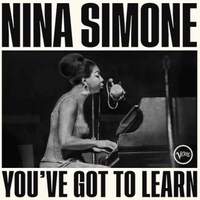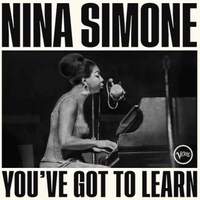Recording of the Week,
Nina Simone - You've Got To Learn

With the Vietnam War continuing to rage overseas and the increasing struggle for equality taking place much closer to home, 1966 is a year that could sum up the increasing socio-political tension felt during that tumultuous period in modern American history. In a live recording which lasts all of half an hour, a performance at that year’s Newport Jazz Festival similarly found Nina Simone standing at the crossroads between two conflicting personae: the virtuosic pianist, rapidly coming to know universal acclaim, and the burgeoning political activist, whose narrative was about to be irrevocably altered as she ventured into Black Radicalism.

No stranger to the Newport stage, Simone had appeared just six years earlier on the festival’s opening night, the blossoming musician’s biggest gig to date. Having already returned once during the time since that initial concert, the 1966 lineup saw ‘Miss Nina Simone’ situated at the unassuming halfway point of Saturday’s bill, topped by singer Joe Williams with support from the Thelonious Monk Quartet. John Coltrane also made an appearance that same afternoon in an intensely heated set, which would prove to be his final performance at the event.

This recording begins gently as Simone kicks off her set with ‘You’ve Got To Learn’, an emotive Charles Aznavour-penned ballad which tells of the courage of nursing a broken heart. This sets the scene for a free-flowing interpretation of the Gershwin-standard, ‘I Loves You Porgy’, the song that launched Simone’s career in the public eye on her debut album, Little Girl Blue (1959). Originally a duet, Lisle Atkinson’s double bass here takes the place of the titular Porgy as Simone accompanies herself on the piano. This sets the scene for ‘Blues For Mama’, which she introduces as a ‘gut bucket blues’ – “It’ll appeal to a certain type of woman who'll have had this kind of experience.” – at which point, the High Priestess of Soul lets rip. The instrumentation is well-balanced, with Rudy Stevenson’s guitar licks taking centre stage in a call-and-response with Simone’s hammering riffs. Among the many of her audience interactions, it is at this point where she knowingly acknowledges the crowd in a teasing manner, as she coyly provokes, “[I] guess you ain’t ready for that.” The singer quipped a similar remark over a vamp during the first major performance of her civil-rights anthem, ‘Mississippi Goddam’, in a recording made before a predominantly-white audience at New York’s Carnegie Hall, two years prior. It was with this live album, Nina Simone In Concert (1964), that the performer slowly but surely began to introduce an astute social commentary into her work, spurred on by a change in record distributor from the American company, Colpix, to the European-based Philips. Having routinely included songs in her repertoire that drew on her African-American heritage, this forthcoming chapter of her career properly signalled Simone's transition from a rising crossover-star of the contemporary jazz scene into a fully-fledged icon of Black History.
The magic of this veritable time-capsule gradually reveals itself as we overhear the offhand interactions between Simone and the members of her band. Her fiery spirit shines through in the build-up to ‘Be My Husband’, for instance, as she pointedly directs drummer Robert Hamilton’s crucial high-hat to keep up with her energetic foot-stomps and idiosyncratic vocal mannerisms: “Let’s go… You better floor it, huh.” Whether or not these interjections were intended to be picked up by the microphone, we can’t say, but the fact they make it onto the record suggests Nina had no qualms about appearing unpolished before a crowd of thousands, if it meant getting the musical result she was after. Even the soft murmur of weather-based background noise infiltrates the mix, to which the chanteuse cheekily observes, “It’s nice out here in this wind.” Over the course of the following number, the sonic disturbance grows into a perseverant rumble, as if to symbolise the turbulence which lay beneath the surface of Simone’s music and lyrics.

The set culminates in a swinging take on ‘Mississippi Goddam’, more laid-back in musical feel here than on its famous debut recording. In no way, however, does the gear-shift in tempo diminish the topical urgency which the piece carries – its lyrics updated, in this version, in reference to the more recent Watts Uprising. Perhaps the most notable event to occur since the 16th Street Baptist Church Bombing, which had inspired the song in the first place, was the assassination of Malcolm X – whose wife, Betty Shabazz, had at one time been a former neighbour of Simone’s in Mount Vernon, NY – on 21st February, 1965, the singer’s 32nd birthday. If anything, the set-closer’s downbeat bounce thus lends her lyrics a more potent weight. When she sings, “I’ve even stopped believing in prayer,” you take it as a solemn gospel. One can’t help but imagine the extent to which Nina was affected by the pent-up frustration she presumably had felt towards the turning point of the Civil Rights Movement. Having permitted her revolutionary fervency to emerge in short bursts up until then, as a performer she had concealed the full scope of her firebrand personality in ambiguous corners, perhaps facing pressure to retain her commercial appeal. Nevertheless, her undoubtful vexation with the state of the nation is evident, reflected in the way her political activism began to intertwine with her art to the point where the two became inseparable; the former soon rising to overtake the rate of her recording output.
Surrendering to her audience’s wishes for an inevitable encore – this time, a solo rendition of ‘Music For Lovers’ – Simone arrives to a rapturous ovation truly befitting a diva of her stature, before once again sitting down at the piano. For a recording that exhibits the artist wearing her heart on her sleeve, to her listeners, this performance was surely a sign of things to come. For those unattuned to the artist’s vulnerable exasperation or passionate rage, well… they just weren’t ready for it yet.
Available Formats: CD, MP3, FLAC, Hi-Res FLAC, Hi-Res+ FLAC




